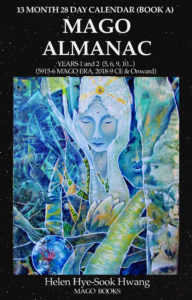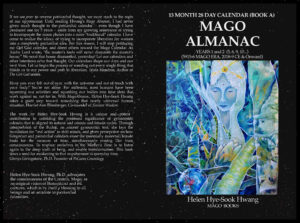 Title Mago Almanac: 13 Month 28 Day Calendar (Book A) Volume 2
Title Mago Almanac: 13 Month 28 Day Calendar (Book A) Volume 2
Subtitle Years 1 and 2 (5, 6, 9, 10…), 5915-6 MAGO ERA, 2018-9 CE
Author Helen Hye-Sook Hwang, Ph.D.
[Volume 2 (equivalent to the Gregorian year 2019) is published to mark Year 2 (5916 Magoma Era) separately. It employs the term “5916 Magoma Era” for ME in place of “Mago Era” in that the former specifically refers to the beginning year of Danguk founded by Goma. Otherwise, it remains identical as Volume 1 with the exception of the book cover art by Deborah Milton, Ph.D. and ISBN numbers.]
This almanac functions as a handbook for us moderns to enter an archaically new way of understanding time/space, the inter-cosmic time, operating in the Magoist Calendar. We are about to pass a threshold and walk into the (M)otherworld. The Magoist Calendar, the book of the Creatrix, summons the Reality of the Creatrix, WE/HERE/NOW, the ultimate destination of human intelligence/spirituality. The Mago Almanac awakens her user to the last reserved revolutionary call in our time, to dismantle the patriarchal calendar and return it to its sender, godfathers. Disassembling the engine of patriarchy, the Magoist Calendar leads its captives to the Mother Time wherein all beings are found kindred. Ultimately, the Mago Almanac is a roadmap to our reunion with the Mother Creator.
This booklet not only introduces the germs and seeds of the Magoist Calendar but also provides the reader with necessary calendric translations. In order to access the seemingly defunct the 28 day/13 month gynocentric calendar, we need to rely on the languages of such 12 months (read patriarchal) calendars as the Gregorian Calendar and the Sinocentric lunisolar calendar with which we moderns are familiar. Through this almanac, we will be versed in both calendars, the 12 months and the 13 months, and measure them in tandem to see which one is rhythmic, which one is nature-based, and which one lifts us up to stay connected with all other beings.
This booklet has three parts: Part I includes 5 charts of 13 month/28 day calendar basics, Part II includes the actual workbook of 13 months with Gregorian dates translations accompanied by Mary Daly quotes from Wickedary, and Part III includes author’s research on the Magoist Calendar based on the Budoji, primary text of Magoism.
Book A (Year 1 and Year 2) stands for the year of 2018 in the Gregorian Calendar (from December 17, 2017 till December 16, 2018) and the year of 2019 in the Gregorian Calendar (from December 17, 2018 till December 16, 2019).
Year 1 (5915 Mago Era) begins on December 17, 2017, the one intercalary day that comes on the day before the New Year’s Day. Its New Year’s day on December 18, 2017 marks the new moon day in the first month of the winter solstice in the Northern Hemisphere.
Year 2 (5916 Mago Era) will be the same as Year 1. It begins with the one intercalary day of December 17, 2018. Its New Year’s day is December 18, 2018. However, it won’t be the new moon day since the moon’s phases are not exactly the same as the moon’s motions for the coming years. For this reason and the Gregorian Calendar’s intermittent dates involved in Book B, Mago Almanac plans to publish its yearly booklet.
 Back Cover Endorsements
Back Cover Endorsements
If we are ever to reverse patriarchal thought, we must reach to the roots of our oppressions. Until reading Hwang’s Mago Almanac, I had never given much thought to the patriarchal calendar – even though I have produced one for 5 years – aside from my growing annoyance of trying to incorporate the moon phases into a more “traditional” calendar. I have come to realize the idiocy of trying to incorporate liberation for women into a completely patriarchal idea. For this reason, I will stop producing my Girl God calendar, and direct others toward the Mago Calendar. As Audre Lorde wrote, “the master’s tools will never dismantle the master’s house.” We need that house dismantled, yesterday! Let our calendars and other intentions echo that thought. Our calendars shape our days and our very lives. Let us begin the process of weeding out every single thing that blinds us to our power and path to liberation. Trista Hendren, author of The Girl God series
Have you ever felt out-of-sync with the universe and out-of-touch with your body? You’re not alone. For millennia, most humans have been squeezing our activities and squashing our bodies into time slots that work against us, not for us. With Mago Almanac, Helen Hye-Sook Hwang takes a giant step toward remedying that nearly universal human situation. Harriet Ann Ellenberger, co-founder of Sinister Wisdom
This work by Helen Hye-Sook Hwang is a unique and potent contribution to unfolding the profound significance of gynocentric calendar; that is, a calendar that is aligned to natural and cosmic and female cycles. The aligning of the small self and also the communal self to Larger Self, is to tune all these layers of being to a cosmic harmony: it is to place one’s self in real time and space. Helen Hye-Sook Hwang radically articulates the vain nature of patriarchal calendar, and its interlock with patriarchal thought and rule. Through interpretation of the Budoji, an ancient gynocentric text, she lays the foundation for real action to shift minds, and gives perspective on how Gregorian and patriarchal calendars erase the essentially maternal/female basis for the measure of time, simultaneously erasing Her from consciousness. To re-place ourselves in the Mother’s Time is to listen again to the deep truth of being, and enable transformation. This book sows a seed for awakening to that re-placement in everyday time. Glenys Livingstone, Ph.D., founder of PaGaian Cosmology

You must be logged in to post a comment.